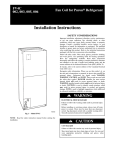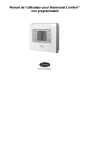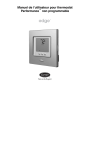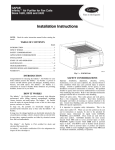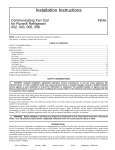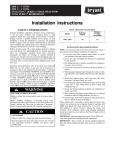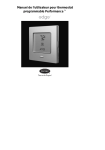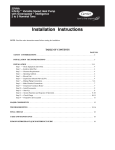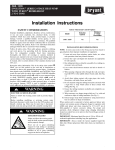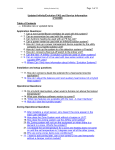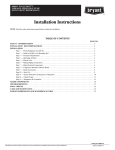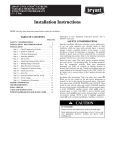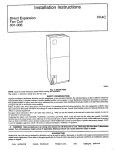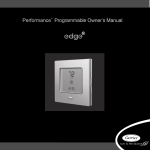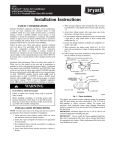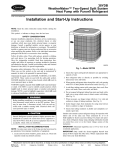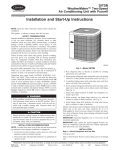Download Installation Instructions
Transcript
25HNA Infinityt Series Heat Pump with Puronr Refrigerant 2 To 5 Nominal Tons (Sizes 24 to 60) Installation Instructions TABLE OF CONTENTS PAGE SAFETY CONSIDERATIONS . . . . . . . . . . . . . . . . . . . . . . . 2 INSTALLATION RECOMMENDATIONS . . . . . . . . . . . . . 2 INSTALLATION . . . . . . . . . . . . . . . . . . . . . . . . . . . . . . 3 − 13 Step 1 − Check Equipment & Job site . . . . . . . . . . . . . . . 3 Step 2 − Install on Solid Pad . . . . . . . . . . . . . . . . . . . . . . 3 Step 3 − Clearance Requirements . . . . . . . . . . . . . . . . . . 3 Step 4 − Operating Ambient . . . . . . . . . . . . . . . . . . . . . . 3 Step 5 − Elevate Unit . . . . . . . . . . . . . . . . . . . . . . . . 3 − 4 Step 6 − Install TXV . . . . . . . . . . . . . . . . . . . . . . . . . . . . 4 Step 7 − Install Liquid−Line Solenoid Valve (LSV) . . . . 5 Step 8 − Make Piping Connections . . . . . . . . . . . . . . 5 − 7 Step 9 − Make Electrical Connections . . . . . . . . . . . . 7 − 8 Step 10 − Compressor Crankcase Heater . . . . . . . . . . . . . 8 Step 11 − Install Accessories . . . . . . . . . . . . . . . . . . . . . . 8 Step 12 − Make Airflow Selections . . . . . . . . . . . . . . . . . . 8 Step 13 − Start−Up . . . . . . . . . . . . . . . . . . . . . . . . . . . . . . 9 the environmentally sound refrigerant A05240 Fig. 1 − 25HNA6 / 25HNA9 Step 14 − System Functions and Sequence of Operation . . . . . . . . . . . . . . . . . . . . . . . . . . . . . . . . . 9 − 12 Step 15 − Check Charge . . . . . . . . . . . . . . . . . . . . . 12 − 13 NOTE: Read the entire instruction manual before starting the installation. Unless otherwise noted, information in these installation instructions pertain to both 25HNA6 and 25HNA9 series units. Information that is unique to the 25HNA6 series will be identified as such; likewise information that is unique to the 25HNA9 series will also be identified. Indoor Thermostat Control Options Standard Infinity 2−stage Model Control Thermostat 25HNA6 Yes Yes 25HNA9 Yes No (Emergency Mode Only) MAJOR COMPONENTS . . . . . . . . . . . . . . . . . . . . . . . . . . 14 TROUBLESHOOTING . . . . . . . . . . . . . . . . . . . . . . . . 14 − 19 FINAL CHECKS . . . . . . . . . . . . . . . . . . . . . . . . . . . . . . . . . 20 CARE AND MAINTENANCE . . . . . . . . . . . . . . . . . . . . . . 20 PURONR REFRIGERANT QUICK REF. GUIDE . . . . . 20 INSTALLATION RECOMMENDATIONS NOTE: In some cases noise in the living area has been traced to gas pulsations from improper installation of equipment. 1. Locate unit away from windows, patios, decks, etc. where unit operation sound may disturb customer. 2. Ensure that vapor and liquid tube diameters are appropriate for unit capacity. 3. Run refrigerant tubes as directly as possible by avoiding unnecessary turns and bends. 4. Leave some slack between structure and unit to absorb vibration. 5. When passing refrigerant tubes through the wall, seal opening with RTV or other pliable silicon−based caulk. (See Fig. 2.) 6. Avoid direct tubing contact with water pipes, duct work, floor joists, wall studs, floors, and walls. 7. Do not suspend refrigerant tubing from joists and studs with a rigid wire or strap which comes in direct contact with tubing.(See Fig. 2.) 8. Ensure that tubing insulation is pliable and completely surrounds vapor tube. 9. When necessary, use hanger straps which are 1 in. wide and conform to shape of tubing insulation. (See Fig. 2.) 10. Isolate hanger straps from insulation by using metal sleeves bent to conform to shape of insulation. When outdoor unit is connected to factory−approved indoor unit, outdoor unit contains system refrigerant charge for operation with ARI rated indoor unit when connected by 15 ft. of field−supplied or factory accessory tubing. For proper unit operation, check refrigerant charge using charging information located on control box cover and/or in the Check Charge section of this instruction. IMPORTANT: Maximum liquid−line size is 3/8−in. OD for all residential applications including long line applications. IMPORTANT: Always install the factory−supplied liquid−line filter drier. Obtain replacement filter driers from your distributor or branch. 25HNA SAFETY CONSIDERATIONS Improper installation, adjustment, alteration, service, maintenance, or use can cause explosion, fire, electrical shock, or other conditions which may cause death, personal injury, or property damage. Consult a qualified installer, service agency, or your distributor or branch for information or assistance. The qualified installer or agency must use factory−authorized kits or accessories when modifying this product. Refer to the individual instructions packaged with the kits or accessories when installing. Follow all safety codes. Wear safety glasses, protective clothing, and work gloves. Use quenching cloth for brazing operations. Have fire extinguisher available. Read these instructions thoroughly and follow all warnings or cautions included in literature and attached to the unit. Consult local building codes and National Electrical Code (NEC) for special requirements. Recognize safety information. This is the safety−alert symbol ! When you see this symbol on the unit and in instructions or manuals, be alert to the potential for personal injury. Understand these signal words: DANGER, WARNING, and CAUTION. These words are used with the safety−alert symbol. DANGER identifies the most serious hazards which will result in severe personal injury or death. WARNING signifies hazards which could result in personal injury or death. CAUTION is used to identify unsafe practices which may result in minor personal injury or product and property damage. NOTE is used to highlight suggestions which will result in enhanced installation, reliability, or operation. WARNING ! ELECTRICAL SHOCK HAZARD Failure to follow this warning could result in personal injury or death. Before installing, modifying, or servicing system, main electrical disconnect switch must be in the OFF position. There may be more than 1 disconnect switch. Lock out and tag switch with a suitable warning label. ! WARNING UNIT OPERATION AND SAFETY HAZARD Failure to follow this warning could result in personal injury or equipment damage. Puron refrigerant systems operate at higher pressures than standard R−22 systems. Do not use R−22 service equipment or components on Puron refrigerant equipment. 2 INSTALLATION NOTE: Avoid contact between tubing and structure. OUTDOOR WALL INDOOR WALL CAULK INSULATION LIQUID TUBE VAPOR TUBE THROUGH THE WALL JOIST INSULATION VAPOR TUBE UNIT BASE PAN DIMENSIONS 1” MIN. SUSPENSION 36−1/2 x 40 LIQUID TUBE TIEDOWN KNOCKOUT LOCATIONS A B C 11−5/8 6−13/16 28−3/4 A05242 Fig. 3 − Tiedown Knockout Locations A94026 NOTE: Unit must be level to within 2 (3/8 in./ft.) per compressor manufacturer specifications. Step 3 Clearance Requirements When installing, allow sufficient space for airflow clearance, wiring, refrigerant piping, and service. Allow 30−in. clearance to service end of unit and 48 in. above unit. For proper airflow, a 6−in. clearance on 1 side of unit and 12 in. on all remaining sides must be maintained. Maintain a distance of 24 in. between units. Position so water, snow, or ice from roof or eaves cannot fall directly on unit. On rooftop applications, locate unit at least 6 in. above roof surface. Step 4 Operating Ambient The minimum outdoor operating ambient in cooling mode is 55F without low ambient cooling enabled and the maximum outdoor operating ambient in cooling mode is 125F. On Infinity communicating systems only (for both 25HNA6 and 25HNA9), low ambient cooling is available to 0F. The maximum outdoor operating ambient in heating mode is 66F on all models. Continuous operation in the heating mode is approved to −30F. Step 5 Elevate Unit Fig. 2 − Connecting Tube Installation Specifications for this unit in residential new construction market require the outdoor unit, indoor unit, refrigerant tubing sets, metering device, and filter drier listed in presale literature. There can be no deviation. Consult the Service Manual – Air Conditioners and Heat Pumps Using Puron Refrigerant to obtain required unit changes for specific applications and for R−22 retrofit. Step 1 Check Equipment and Job Site Unpack Unit Move to final location. Remove carton taking care not to damage unit. Inspect Equipment File claim with shipping company prior to installation if shipment is damaged or incomplete. Locate unit rating plate on unit corner panel. It contains information needed to properly install unit. Check rating plate to be sure unit matches job specifications. Step 2 Install on a Solid, Level Mounting Pad If conditions or local codes require the unit be attached to pad, tie down bolts should be used and fastened through knockouts provided in unit base pan. Refer to unit mounting pattern in Fig. 3 to determine base pan size and knockout hole location. For hurricane tie downs, contact distributor for details and PE (Professional Engineer)Certification, if required. On rooftop applications, mount on level platform or frame. Place unit above a load−bearing wall and isolate unit and tubing set from structure. Arrange supporting members to adequately support unit and minimize transmission of vibration to building. Consult local codes governing rooftop applications. Roof mounted units exposed to winds above 5 mph may require wind baffles. Consult the Service Manual − Residential Split System Air Conditioners and Heat Pumps Using Puron Refrigerant for wind baffle construction. ! CAUTION UNIT OPERATION HAZARD Failure to follow this caution may result in equipment damage or improper operation. Do not allow water and/or ice to build up in base pan. Elevate unit per local climate and code requirements to provide clearance above estimated snowfall level and ensure adequate drainage of unit. 3 25HNA HANGER STRAP (AROUND VAPOR TUBE ONLY) ! 7. Connect equalizer tube of TXV to 1/4−in. equalizer fitting on vapor line adapter. 8. Attach TXV bulb to horizontal section of suction line using clamps provided. Insulate bulb with field−supplied insulation tape. See Fig. 4 for correct positioning of sensing bulb. 9. Proceed with remainder of unit installation. CAUTION UNIT OPERATION HAZARD Failure to follow this caution may result in equipment damage or improper operation. 25HNA Locate the unit in such a way that it is stable in all circumstances including adverse weather conditions. 10 O'CLOCK 2 O'CLOCK SENSING BULB Step 6 Install Thermostatic Expansion Valve (TXV) NOTE: Applies to non−TXV indoor units only. If installing a rated and approved indoor coil without a factory−installed Puron TXV, remove and replace the fixed orifice or R−22 TXV expansion device with a hard−shutoff Puron TXV. The TXV is specifically designed to operate with Puron refrigerant. Do not use an R−22 TXV. An existing R−22 TXV must be replaced with a factory−approved TXV specifically designed for Puron refrigerant. Refer to Product Data Digest for the appropriate TXV kit number. ! STRAP SUCTION TUBE 8 O'CLOCK 7⁄ 8 CAUTION LARGER THAN 7⁄ 8 IN. OD A81032 Fig. 4 − Position of Sensing Bulb Replacing TXV on R−22 Indoor Coil 1. Pump system down to 2 psig and recover refrigerant. 2. Remove coil access panel and fitting panel from front of cabinet. 3. Remove TXV support clamp using a 5/16−in. nut driver. Save the clamp. 4. Remove R−22 TXV using a backup wrench on flare connections to prevent damage to tubing. 5. Using wire cutters, cut equalizer tube off flush with vapor tube inside cabinet. 6. Remove bulb from vapor tube inside cabinet. 7. Braze equalizer stub tube closed. Use protective barrier, as necessary, to prevent damage to drain pan. IMPORTANT: Route the equalizer tube of Puron refrigerant TXV through suction line connection opening in fitting panel prior to replacing fitting panel around tubing. 8. Install TXV with 3/8−in. copper tubing through small hole in service panel. Use wrench and backup wrench, to avoid damage to tubing or valve, to attach TXV to distributor. 9. Reinstall TXV support clamp (removed in item 3). 10. Attach TXV bulb to vapor tube inside cabinet, in same location as original was when removed, using supplied copper bulb clamps. See Fig. 4 for correct positioning of sensing bulb. 11. Route equalizer tube through suction connection opening (large hole) in fitting panel and install fitting panel in place. 12. Sweat inlet of TXV, marked “IN” to liquid−line. Avoid excessive heat which could damage valve. 13. Install vapor elbow with equalizer adapter to vapor line of line set and vapor connection to indoor coil. Adapter has a 1/4−in. male connector for attaching equalizer tube. 14. Connect equalizer tube of TXV to 1/4−in. equalizer fitting on vapor line adapter. Use backup wrench to prevent damage to equalizer fitting. 15. Proceed with remainder of unit installation. UNIT OPERATION HAZARD Failure to follow this caution may result in equipment damage or improper operation. All indoor coil units must be installed with a hard shut off Puron refrigerant TXV metering device. IMPORTANT: The TXV should be mounted as close to the indoor coil as possible and in a vertical, upright position. Avoid mounting the inlet tube vertically down. Valve is more susceptible to malfunction due to debris if inlet tube is facing down. A factory−approved filter drier must be installed in the Liquid−line. Installing TXV in Place of Piston 1. Pump system down to 2 psig and recover refrigerant. 2. Remove hex nut from piston body. Use backup wrench on fan coils. 3. Remove and discard factory−installed piston. Be sure Teflon seal is in place. 4. Reinstall hex nut. Finger tighten nut plus 1/2 turn. NOTE: If the piston is not removed from the body, TXV will not function properly. ! IN. OD & SMALLER 4 O'CLOCK CAUTION EQUIPMENT DAMAGE HAZARD Failure to follow this caution may result in equipment damage or improper operation. Use a brazing shield and wrap TXV with wet cloth or use heat sink material. 5. Install TXV on indoor coil liquid−line. Sweat swivel adapter to inlet of indoor coil and attach to TXV outlet. Use backup wrench to avoid damage to tubing or valve. Sweat inlet of TXV, marked “IN” to liquid−line. Avoid excessive heat which could damage valve. 6. Install vapor elbow with equalizer adapter to suction tube of line set and suction connection to indoor coil. Adapter has a 1/4−in. male connector for attaching equalizer tube. 4 Step 7 In Long−Line Applications, Install Liquid−Line Solenoid Valve (LSV) For refrigerant piping arrangements with equivalent lengths greater than 80 ft. and/or when elevation difference between indoor and outdoor unit is greater than ft., follow all requirements of the Long−Line Guideline—Air Conditioners and Heat Pumps Using Puron refrigerant. If required by Long−Line Guideline, install LSV kit, part no. KHALS0401LLS, specifically designed for Puron refrigerant heat pumps. LSV should be installed within 2 ft. of outdoor unit with flow arrow pointing toward outdoor unit. Follow the Installation Instructions included with accessory kit. IMPORTANT: Flow arrow must point toward outdoor unit. Step 8 Make Piping Connections ! UNIT DAMAGE HAZARD Failure to follow this caution may result in equipment damage or improper operation. If ANY refrigerant tubing is buried, provide a 6 in. vertical rise at service valve. Refrigerant tubing lengths up to 36 in. may be buried without further special consideration. Do not bury lines longer than 36 in. ! WARNING UNIT DAMAGE HAZARD Failure to follow this caution may result in equipment damage or improper operation. PERSONAL INJURY AND UNIT DAMAGE HAZARD Observe the following: Use a brazing shield. Wrap service valves with wet cloth or use a heat sink material. Failure to follow this warning could result in personal injury or death. Relieve pressure and recover all refrigerant before system repair or final unit disposal. Use all service ports and open all flow−control devices, including solenoid valves. ! CAUTION Outdoor units may be connected to indoor section using accessory tubing package or field−supplied refrigerant grade tubing of correct size and condition. For tubing requirements beyond 80 ft., substantial capacity and performance losses can occur. Following the recommendations in the Application Guideline and Service Manual−Residential Split−System Air Conditioners and Heat Pumps Using Puron Refrigerant will reduce these losses. Refer to Table 1 for field tubing diameters. Refer to Table 2 for accessory requirements. Outdoor Unit Connected to Factory−Approved Indoor Unit Outdoor unit contains correct system refrigerant charge for operation with factory−approved, ARI−rated indoor unit with highest sales volume when connected by 15 ft. of field−supplied or factory−accessory tubing, and factory−supplied filter drier. Check refrigerant charge for maximum efficiency. CAUTION UNIT DAMAGE HAZARD Failure to follow this caution may result in equipment damage or improper operation. Do not leave system open to atmosphere any longer than minimum required for installation. POE oil in compressor is extremely susceptible to moisture absorption. Always keep ends of tubing sealed during installation. Table 1—Refrigerant Connections and Recommended Liquid and Vapor Tube Diameters (In.) Information is Specific to 25HNA6 and 25HNA9 Models RATED VAPOR (up to 80 ft. T.E.L) LIQUID UNIT SIZE Connection Diameter Tube Diameter Connection Diameter Tube Diameter 25HNA624 3/8 3/8 5/8 5/8 25HNA636 3/8 3/8 3/4 3/4 25HNA648 3/8 3/8 7/8 7/8 25HNA660 3/8 3/8 7/8 1−1/8 25HNA924 3/8 3/8 3/4 3/4 25HNA936 3/8 3/8 3/4 3/4 25HNA948 3/8 3/8 7/8 7/8 25HNA960 3/8 3/8 7/8 1−1/8 Notes: 1. Tube diameters are for total equivalent lengths (T.E.L.) up to 80 ft. Consult the Long Line GuidelineAir Conditioners and Heat Pumps using Puron refrigerant. 2. Do not apply capillary tube or the fixed orifice indoor coils to these units. 3. T.E.L. − Total Equivalent Length 5 25HNA ! CAUTION Table 2—Accessory Usage REQUIRED FOR LOW−AMBIENT APPLICATIONS (Below 55 5F) Standard Standard with Infinity Control REQUIRED FOR LONG LINE APPLICATIONS* (Over 80 ft.) Standard REQUIRED FOR SEA COAST APPLICATIONS (Within 2 miles) Standard Evaporator Freeze Protection (Low Ambient not allowed with non− communicating thermostat) No No Winter Start Control (Low Ambient not allowed with non− communicating thermostat) No No Standard on 25HNA6 models. Not required on 25HNA9 models since compressor always starts unloaded. Standard on 25HNA6 models. Not required on 25HNA9 models since compressor always starts unloaded. Standard on 25HNA6 models. Not required on 25HNA9 models since compressor always starts unloaded. No No No ACCESSORY Crankcase Heater Standard with Infinity Control Compressor Start Assist Capacitor and Relay} 25HNA Standard with Infinity Control (Low Low−Ambient Control ambient not allowed with non−communicating thermostat) Support Feet Liquid−Line Solenoid Valve Ball−Bearing Fan Motor Puron Refrigerant Balance Port Hard−ShutOff TXV Recommended No Standard Standard Recommended No Standard Yes Yes Yes Yes * For tubing set lengths between 80 and 200 ft. horizontal or 20 ft. vertical differential (total equivalent length), refer to the Long Line GuidelineAir Conditioners and Heat Pumps using Puron Refrigerant. Required on all indoor units. Standard on all new Puron refrigerant fan coils and furnace coils. Information is specific to 25HNA6 and 25HNA9 models. Refrigerant Tubing connection Outdoor Connect vapor tube to fitting on outdoor unit vapor service valves (see Table 1). Install Adapter Tube 1. Remove plastic retainer holding outdoor piston in liquid service valve. 2. Check outdoor piston size with matching number listed on unit rating plate. 3. Locate plastic bag taped to unit containing adapter tube. 4. Remove Teflon washer from bag and install on open end of liquid service valve. 5. Remove adapter tube from bag and connect threaded nut to liquid service valve. Tighten nut finger tight and then with wrench tighten an additional 1/2 turn (15 ft−lb). DO NOT OVERTIGHTEN! Sweat Connections Install Liquid−Line Filter Drier Indoor Refer to Fig. 5 and install filter drier as follows: 1. Braze 5−in. liquid tube to the indoor coil. 2. Wrap filter drier with damp cloth. 3. Braze filter drier to above 5−in. liquid tube. Flow arrow must point towards indoor coil. 4. Connect and braze liquid refrigerant tube to the filter drier. ! CAUTION UNIT DAMAGE HAZARD Failure to follow this caution may result in equipment damage or improper operation. Installation of filter drier in liquid line is required. ! CAUTION UNIT DAMAGE HAZARD Failure to follow this caution may result in equipment damage or improper operation. Service valves must be wrapped in a heat−sink material such as a wet cloth. Use refrigerant grade tubing. Service valves are closed from factory and ready for brazing. After wrapping service valve with a wet cloth, braze sweat connections using industry accepted methods and materials. Consult local code requirements. Refrigerant tubing and indoor coil are now ready for leak testing. This check should include all field and factory joints. A05227 Fig. 5 − Liquid−Line Filter Drier 6 Evacuate Refrigerant Tubing and Indoor Coil EVACUATE CAUTION BREAK VACUUM WITH DRY NITROGEN WAIT UNIT DAMAGE HAZARD Failure to follow this caution may result in equipment damage or improper operation. EVACUATE Never use the system compressor as a vacuum pump. BREAK VACUUM WITH DRY NITROGEN WAIT Refrigerant tubes and indoor coil should be evacuated using the recommended deep vacuum method of 500 microns. The alternate triple evacuation method may be used if the procedure outlined below is followed. Always break a vacuum with dry nitrogen. Deep Vacuum Method The deep vacuum method requires a vacuum pump capable of pulling a vacuum of 500 microns and a vacuum gauge capable of accurately measuring this vacuum depth. The deep vacuum method is the most positive way of assuring a system is free of air and liquid water. (See Fig. 6) 5000 4500 4000 3500 3000 2500 2000 1500 1000 500 EVACUATE CHECK FOR TIGHT, DRY SYSTEM (IF IT HOLDS DEEP VACUUM) CHARGE SYSTEM A95425 Fig. 7 − Triple Evacuation Method Final Tubing Check IMPORTANT: Check to be certain factory tubing on both indoor and outdoor unit has not shifted during shipment. Ensure tubes are not rubbing against each other or any sheet metal. Pay close attention to feeder tubes, making sure wire ties on feeder tubes are secure and tight. Step 9 Make Electrical Connections MICRONS LEAK IN SYSTEM ! VACUUM TIGHT TOO WET 1 2 3 4 5 MINUTES 6 7 WARNING ELECTRICAL SHOCK HAZARD TIGHT DRY SYSTEM 0 25HNA ! Failure to follow this warning could result in personal injury or death. Do not supply power to unit with compressor terminal box cover removed. A95424 A95424 Fig. 6 − Deep Vacuum Graph Be sure field wiring complies with local and national fire, safety, and electrical codes, and voltage to system is within limits shown on unit rating plate. Contact local power company for correction of improper voltage. See unit rating plate for recommended circuit protection device. NOTE: Operation of unit on improper line voltage constitutes abuse and could affect unit reliability. See unit rating plate. Do not install unit in system where voltage may fluctuate above or below permissible limits. NOTE: Use copper wire only between disconnect switch and unit. NOTE: Install branch circuit disconnect of adequate size per NEC to handle unit starting current. Locate disconnect within sight from and readily accessible from unit, per Section 440−14 of NEC. Route Ground and Power Wires Remove access panel to gain access to unit wiring. Extend wires from disconnect through power wiring hole provided and into unit control box. Triple Evacuation Method The triple evacuation method should only be used when vacuum pump is only capable of pumping down to 28 in. of mercury vacuum and system does not contain any liquid water. Refer to Fig. 7 and proceed as follows: 1. Pump system down to 28 in. of mercury and allow pump to continue operating for an additional 15 minutes. 2. Close service valves and shut off vacuum pump. 3. Connect a nitrogen cylinder and regulator to system and open until system pressure is 2 psig. 4. Close service valve and allow system to stand for 1 hr. During this time, dry nitrogen will be able to diffuse throughout the system absorbing moisture. 5. Repeat this procedure as indicated in Fig. 7. System will then be free of any contaminants and water vapor. 7 ! Step 10 Compressor Crankcase Heater Furnish power to crankcase heater a minimum of 24 hr before starting unit. To furnish power to heater only, set thermostat to OFF and close electrical disconnect to outdoor unit. NOTE: On 25HNA6 models, starting the compressor without a minimum of 12 hours of crankcase heat prior to initial start−up may result in a compressor chattering noise and possible damage to the compressor. Step 11 Install Accessories Refer to the individual instructions packaged with kits or accessories when installing. Step 12 Make Airflow Selections for 25HNA6 Series Only Using Non−Communicating (Non−Infinity) Thermostats Airflow Selection for 58CVA/58MVB Furnaces The 58CVA/58MVB variable−speed furnaces provide high−and low−stage blower operation to match the capacities of the compressor at high and low stages. To select the recommended airflow and for adjustments to the manual switches labeled SW1−5, AC, and CF on the control board, refer to the furnace Installation Instructions. The 58CVA/58MVB utilizes a control center that allows the installing technician to select the proper airflows. The HP switch determines the airflow during high−stage compressor operation. Airflow for high− and low−stage can be calculated at either 350 CFM per ton or 400 CFM per ton, based on the positions of SW1−5. When using communicating (Infinity) control, dipswitch adjustments are not necessary on furnaces. Airflows are determined by Infinity Control setup. Airflow Selection for FV4 Fan Coils for 25HNA6 Series Only Using Non−Communicating (Non−Infinity) Thermostats The FV4 provides high− and low−stage blower operation to match the capacities of compressor at high− and low−stage. To select recommended airflow, refer to FV4 Installation Instructions. The FV4 utilizes an Easy Select control board that allows the installing technician to select proper airflows. For adjustments to control board, select appropriate HP SIZE and CFM ADJUST setting. This fan coil has an adjustable blower off delay factory set at 90 sec for high− and low−stage blower operation. For other combinations of equipment consult Product Data Digest. WARNING ELECTRICAL SHOCK HAZARD Failure to follow this warning could result in personal injury or death. The unit cabinet must have an uninterrupted or unbroken ground to minimize personal injury if an electrical fault should occur. The ground may consist of electrical wire or metal conduit when installed in accordance with existing electrical codes. 25HNA Connect Ground and Power Wires Connect ground wire to ground connection in control box for safety. Connect power wiring to contactor as shown in Fig. 8. DISCONNECT PER N. E. C. AND/OR LOCAL CODES CONTACTOR FIELD POWER WIRING FIELD GROUND WIRING GROUND LUG A91056 Fig. 8 − Line Power Connections Connect Control Wiring Route low voltage control wires through control wiring grommet and connect leads to control board. For 25HNA9 models, connect to Infinity connections ABCD only. Standard non−communicating thermostats are not allowed unless it is an emergency that User Interface is not working properly and new User Interface is not available. For emergency use, connect to standard thermostat connections R, C, W, Y1, Y2, and O. NOTE: When unit is operating in emergency mode, STATUS light will flash rapidly. Unit will operate in high stage ONLY. For 25HNA6 models, connect to ABCD for Infinity Control or standard thermostat connections R, C, W1, Y1, Y2, and O. General Information Use No. 18 AWG color−coded, insulated (35C minimum) wire for all installations. All wiring must be NEC Class 1 and must be separated from incoming power leads. Use furnace transformer, fan coil transformer, or accessory transformer for control power, 24v/40va minimum. The outdoor unit requires a minimum of 27va/24vac control power. Final Wiring Check IMPORTANT: Check factory wiring and field wire connections to ensure terminations are secured properly. Check wire routing to ensure wires are not in contact with tubing, sheet metal, etc. 8 ! Step 14 System Functions and Sequence of Operation The outdoor unit control system has special functions. The following is an overview of the two−stage control functions: Cooling and Heating Operation The 25HNA6 model utilizes either a standard indoor thermostat or Infinity Communication User Interface. The 25HNA9 models utilize an Infinity communicating User Interface only. With a call for first stage cooling, the outdoor fan, reversing valve, and low stage compressor are energized. If low−stage cannot satisfy cooling demand, high−stage cooling is energized by the second stage of indoor thermostat or User Interface. After second stage is satisfied, the unit returns to low−stage operation until first stage is satisfied or until second stage is required again. When both first stage and second stage cooling are satisfied, the compressor will shut off. The reversing valve will remain energized until the control board power is removed or a call for heating in initiated. With a call for heating, the outdoor fan and compressor are energized. The compressor will operate in high or low stage operation, as needed to meet the heating demand. When the heating demand is satisfied, the compressor and fan will shut off. The reversing valve is de−energized in the heating mode. NOTE: When two−stage unit is operating at low−stage, system vapor (suction) pressure will be higher than a standard single−stage system or high−stage operation. NOTE: Outdoor fan motor will continue to operate for one minute after compressor shuts off, when outdoor ambient is greater than or equal to 100F. This reduces pressure differential for easier starting on next cycle. NOTE: On 25HNA6 models, if unit has not operated within the past 12 hours, or following a unit power−up, upon the next thermostat high− or low−stage demand, unit operates for a minimum of 5 minutes in high−stage. On 25HNA6 models with non−communicating (non−Infinity) systems, with first stage of cooling, Y1 and O are powered on; and with second stage of cooling, Y1, Y2, and O are on. For these systems, with first stage of heating Y1 is on and for second stage of heating, Y1 and Y2 are on. When the reversing valve is energized, O is powered on. Communication and Status Function Lights For Infinity Control only, Green communications (COMM) Light A green LED (COMM light) on the outdoor board (see Fig. 9) indicates successful communication with the other system products. The green LED will remain OFF until communication is established. Once a valid command is received, the green LED will turn ON continuously. If no communication is received within 2 minutes, the LED will be turned OFF until the next valid communication. Amber Status Light An amber colored STATUS light is used to display the operation mode and fault codes as specified in the troubleshooting section. See Table 7 for codes and definitions. NOTE: Only one code will be displayed on the outdoor unit control board (the most recent, with the highest priority). Utility Interface With Infinity Control The utility curtailment relay should be wired between R and Y2 connections on the control board for Infinity Communicating Systems only (see Fig. 9.) This input allows a power utility device to interrupt compressor operation during peak load periods. When the utility sends a signal to shut the system down, the User Interface will display, “Curtailment Active”. CAUTION UNIT OPERATION AND SAFETY HAZARD Failure to follow this caution may result in minor personal injury, equipment damage or improper operation. Observe the following: Do not overcharge system with refrigerant. Do not operate unit in a vacuum or at negative pressure. Do not disable low pressure switch Dome temperatures may be hot. ! CAUTION PERSONAL INJURY HAZARD Failure to follow this caution may result in personal injury. Wear safety glasses, protective clothing, and gloves when handling refrigerant. ! CAUTION ENVIRONMENTAL HAZARD Failure to follow this caution may result in environmental damage. Federal regulations require that you do not vent refrigerant to the atmosphere. Recover during system repair or final unit disposal. Follow these steps to properly start up the system: 1. After system is evacuated, fully back seat (open) liquid and vapor service valves. 2. Unit is shipped with valve stem(s) front seated (closed) and caps installed. Replace stem caps after system is opened to refrigerant flow (back seated). Replace caps finger−tight and tighten with wrench an additional 1/12 turn. 3. Close electrical disconnects to energize system. 4. Set room thermostat or User Interface at desired temperature. Be sure set point is below indoor ambient temperature and is set low enough to energize desired stage. 5. Set room thermostat or User Interface to COOL and fan control to ON or AUTO mode, as desired. Operate unit for 15 minutes. Check system refrigerant charge. NOTE: For 25HNA6 Series only using non−communicating (non−Infinity) thermostat. Carrier electronic thermostats are equipped with a 15−minute staging timer. This timer prevents the two−stage system from operating at high stage until unit has been operating in low stage for 15 minutes, unless there is at least a 5F difference between room temperature and thermostat set point. To force high stage (after a minimum of 2 minutes in low stage), adjust the set point at least 5F below room ambient. 6. Set room thermostat or User Interface to HEAT or COOL and fan control to AUTO or ON, as desired. Wait for appropriate time delay(s). Operate unit for 15 minutes. Check refrigerant charge. 9 25HNA Step 13 Start−Up 25HNA One Minute Stage Change Time Delay on 25HNA6 Models When compressor changes stages from high to low or low to high, there is a 1−minute time delay before compressor restarts. The outdoor fan motor remains running. Compressor Operation on 25HNA6 Models When the compressor operates in high stage operation, the compressor motor rotates clockwise. Both the lower and upper pistons are eccentric with the rotating crankshaft and both compress refrigerant. When the compressor operates in low stage operation, the compressor motor reverses direction (rotates counterclockwise). The lower piston becomes idle and the upper piston compresses refrigerant. The start and run windings are reversed. Crankcase Heater Operation The crankcase heater is energized during unit off cycle regardless of outside air temperature (OAT) on 25HNA6 models. The crankcase heater is energized during off cycle below 65F on 25HNA9 models. Outdoor Fan Motor Operation The outdoor unit control energizes outdoor fan anytime compressor is operating, except for defrost or low−ambient cooling. The outdoor fan remains energized if a pressure switch or compressor overload should open. Outdoor fan motor will continue to operate for one minute after the compressor shuts off when the outdoor ambient is greater than or equal to 100F. This reduces pressure differential for easier starting on next cycle. On 25HNA6 models, the outdoor fan remains energized during the 1−minute compressor staging time delay. On 25NHNA6 models, the outdoor fan motor is a PSC type. A fan relay on the control board turns the fan off and on by opening and closing a high voltage circuit to the motor. It does not change speeds between low and high stage operation. On 25HNA9 models, the outdoor fan is an ECM type. The motor control is continuously powered with high voltage. The motor speed is determined by electrical pulses provided by the PWM outputs on the control board. The ECM motor RPM adjusts to outdoor conditions as described in Table 3. The PWM output can be measured with a volt meter set to DC volts. In low ambient cooling (below 55ºF) on 25HNA6 models, the control board cycles the fan off and on, and for 25HNA9 models, the PWM output is adjusted by the control as described in Low Ambient Cooling section. Table 3—Outdoor Fan Motor PWM Above 55_F Outdoor Temp (DC volts, Tolerance +/− 2%) Model 25HNA924 25HNA936 25HNA948 25HNA960 Low Stage (OAT≤104 F) High Stage (OAT≤104 F) 4.0 4.5 6.0 7.8 4.8 6.5 8.1 9.6 Low & High Stage (OAT>104 F) 10.0 10.0 10.0 10.0 NOTE: For 25HNA9 models in low−ambient cooling, the PWM output for both high− and low−stage equals the value for low−stage opera− tion below 104F. Time Delays The unit time delays include: Five minute time delay to start cooling or heating operation when there is a call from the thermostat or user interface. To bypass this feature, momentarily short and release Forced Defrost pins. Five minute compressor re−cycle delay on return from a brown−out condition. Two minute time delay to return to standby operation from last valid communication (with Infinity only). One minute time delay of outdoor fan at termination of cooling mode when outdoor ambient is greater than or equal to 100F. Fifteen second delay at termination of defrost before the auxiliary heat (W1) is de−energized. Twenty second delay at termination of defrost before the outdoor fan is energized. Thirty second compressor delay when quiet shift enabled. On 25HNA6 models there is a 1 minute time delay between staging from low to high and from high to low capacity. On 25HNA9 models there is no delay; the compressor will change from low to high and from high to low capacity “on the fly” to meet the demand. Compressor Operation on 25HNA9 Models: The basic scroll design has been modified with the addition of an internal unloading mechanism that opens a by−pass port in the first compression pocket, effectively reducing the displacement of the scroll. The opening and closing of the by−pass port is controlled by an internal electrically operated solenoid. The modulated scroll uses a single step of unloading to go from full capacity to approximately 67% capacity. A single speed, high efficiency motor continues to run while the scroll modulates between the two capacity steps. Modulation is achieved by venting a portion of the gas in the first suction pocket back to the low side of the compressor, thereby reducing the effective displacement of the compressor. Full capacity is achieved by blocking these vents, thus increasing the displacement to 100%. A DC solenoid in the compressor controlled by a rectified 24 volt AC signal in the external solenoid plug moves the slider ring that covers and uncovers these vents. The vent covers are arranged in such a manner that the compressor operates at approximately 67% capacity when the solenoid is not energized and 100% capacity when the solenoid is energized. The loading and unloading of the two step scroll is done ”on the fly” without shutting off the motor between steps. NOTE: 67% compressor capacity translates to approximately 80% cooling or heating capacity at the indoor coil. The compressor will always start unloaded and stay unloaded for five seconds even when the thermostat is calling for high stage capacity. 10 MODEL PLUG UTILITY RELAY 25HNA MODEL PLUG * UTILITY SIGNAL OPEN RELAY LLS * SUPPLIED BY UTILITY PROVIDER Liquid Line Solenoid A06525 A06526 Fig. 9 − 2−Stage Control Board GENERAL INFORMATION Low Ambient Cooling When this unit is operating below 55F outdoor temperature, provisions must be made for low ambient operation. Infinity Controlled low ambient cooling: This unit is capable of low ambient cooling without a kit ONLY when using Infinity control. A low ambient kit is not required, and the outdoor fan motor does not need to be replaced for Infinity controlled low ambient operation. The Infinity Control provides an automatic evaporator coil freeze protection algorithm that eliminates the need for an evaporator freeze thermostat. Low ambient cooling must be enabled in the User Interface set up. Fan may not begin to cycle until about 40F OAT. Fan will cycle based on coil and outdoor air temperature. Infinity controlled low ambient mode operates as follows: Fan is OFF when outdoor coil temp is < (outdoor air temperature + 3F) or outdoor fan has been ON for 30 minutes. (Fan is turned off to allow refrigerant system to stabilize.) Fan is ON when outdoor coil temp > (outdoor air temperature + 25F) or outdoor coil temp > 80F or if outdoor fan has been OFF for 30 minutes. (Fan is turned on to allow refrigerant system to stabilize.) Low pressure switch is ignored for first 3 minutes during low ambient start up. After 3 minutes, if LPS trips, then outdoor fan motor is turned off for 10 minutes, with the compressor running. If LPS closes within 10 minutes then cooling continues with the outdoor fan cycling per the coil temperature routine listed above for the remainder of the cooling cycle. If the LPS does not close within 10 minutes, then the normal LPS trip response (shut down cooling operation and generate LPS trip error) will occur. For 25HNA9 models, the PWM output for both high and low stage equals the value for low stage operation below 104F. Defrost This control offers 5 possible defrost interval times: 30, 60, 90, 120 minutes, or AUTO. On 25HNA6 models, these are selected by dip switches on the unit control board or by the Infinity Control User Interface. The Infinity Control selection overrides the control board dip switch settings. On 25HNA9 , the defrost interval times: 30, 60, 90, and 120 minutes or AUTO are selected by the Infinity Control User Interface (the dip switches are not used.) AUTO defrost adjusts the defrost interval time based on the last defrost time as follows: When defrost time <3 minutes, the next defrost interval=120 minutes. When defrost time 3−5 minutes, the next defrost interval=90 minutes. When defrost time 5−7 minutes, the next defrost interval=60 minutes. When defrost time >7 minutes, the next defrost interval=30 minutes. The control board accumulates compressor run time. As the accumulated run time approaches the selected defrost interval time, the control board monitors the coil temperature sensor for a defrost demand. If a defrost demand exists, a defrost cycle will be initiated at the end of the selected time interval. A defrost demand exists when the coil temperature is at or below 32F for 4 minutes during the interval. The defrost cycle is terminated when the coil temperature reaches 65F or 10 minutes has passed. If the coil temperature does not reach 32F within the interval, the interval timer will be reset and start over. Upon initial power up the first defrost interval is defaulted to 30 minutes. Remaining intervals are at selected times. Defrost is only allowed to occur below 50F outdoor ambient temperature. 11 25HNA Defrost Hold On 25HNA6 models, in a non−communicating system, if the thermostat becomes satisfied (Y1 or Y1 and Y2) before the defrost cycle is terminated, the control will “hold” in defrost mode and finish the defrost cycle on the next call for heat. On 25HNA6 models, with communicating Infinity Control and all 25HNA9 models, defrost hold is not needed in a communicating system because the User Interface will complete the defrost cycle before shutting down the system. Forced Defrost On 25HNA6 models with non−communicating (non−Infinity) control, forced defrost can be initiated by manually shorting the 2−pin header labeled FORCED DEFROST (see Fig 9) on the control board for 5 seconds then releasing. On 25HNA6 and 25HNA9 with communicating (Infinity) control, forced defrost is initiated with the User Interface. On all models, during a Forced Defrost: If coil temperature is at defrost temperature of 32F, and outdoor air temperature is below 50F, a full defrost sequence will occur. If coil temperature or outdoor air temperature does not meet the above requirements, an abbreviated 30 second defrost will occur. Quiet Shift Quiet Shift is a field−selectable defrost mode which may eliminate occasional noise that could be heard at the start of the defrost cycle and restarting of the heating cycle. On 25HNA6 models with non−communicating system, this feature must be enabled by selecting the 3rd position of the 3−position dip switch. For 25HNA6 and 25HNA9 models with communicating (Infinity) systems, it must be enabled at the User Interface. When activated, the following sequence of operation will occur. Reversing valve will energize and compressor will turn off for 30 seconds, then turn back on to complete defrost. At the end of the defrost cycle, the reversing valve de−energizes, compressor will turn off for another 30 seconds, and the fan will turn off for 40 seconds, before starting in the heating mode. Liquid−Line Solenoid Accessory In heat pump long−line applications, a liquid−line solenoid is required to control refrigerant migration in the heating mode. The solenoid should be installed near the outdoor unit with the arrow facing the outdoor unit. This is the direction of flow control. See application manual for long−line application details. Accessory Liquid Solenoid with Infinity Communicating Control: When using the Infinity Control, the liquid−line solenoid output is provided at the Y1 connection. Connect the solenoid as shown in the wiring label diagram. This is a 24vac output that is energized whenever the compressor is energized. It closes, in the compressor off mode, to prevent refrigerant migration into the unit through the liquid−line. On 25HNA6 Models with Accessory Liquid Solenoid Using a Non−Communicating Thermostat: The liquid solenoid is connect to the Y1 and C terminal connections. The liquid solenoid closes, in the compressor off mode, to prevent refrigerant migration into the unit through the liquid−line. Step 15 Check Charge Unit Charge Factory charge and charging method are shown on unit information plate. Charge Puron refrigerant units with cylinder in inverted position and a commercial−type metering device in manifold hose. Charge refrigerant into suction line. NOTE: If subcooling charging conditions are not favorable, charge must be weighed in accordance with unit rating plate, 0.6 oz./ft. of 3/8−in. liquid−line above or below 15 ft., respectively. Favorable conditions fall within the ranges given on the charging chart on the outdoor unit plate. EXAMPLE: To calculate additional charge required for a 25−ft. line set: 25 ft. − 15 ft. = 10 ft. X 0.6 oz./ft. = 6 oz. of additional charge. Cooling Only Procedure This system requires charging by the subcooling method. 1. On all units, operate unit a minimum of 10 minutes in high−stage before checking charge. On 25HNA6 models, charging in low stage may cause compressor chattering and possible damage to the compressor. 2. Measure liquid service valve pressure by attaching an accurate gauge to service port. 3. Measure liquid−line temperature by attaching an accurate thermistor−type or electronic thermometer to liquid−line near outdoor coil. 4. Refer to unit rating plate for required subcooling temperature. Subcooling amount is for high stage operation. 5. Refer to Table 4. Find the point where required subcooling temperature intersects measured liquid service valve pressure. 6. To obtain required subcooling temperature at a specific liquid−line pressure, add refrigerant if liquid−line temperature is higher than indicated or reclaim refrigerant if temperature is lower. Allow a tolerance of 3F. 12 Heating Check Chart Procedure To check system operation during heating cycle, refer to the Heat Pump Charging Instructions label on outdoor unit. This chart indicates whether a correct relationship exists between system operating pressure and air temperature entering indoor and outdoor units. If pressure and temperature do not match on chart, system refrigerant charge may not be correct. Do not use chart to adjust refrigerant charge. NOTE: In heating mode, check refrigerant charge only when pressures are stable. If in doubt, remove charge and weigh in correct refrigerant charge. NOTE: When charging is necessary during heating season, charge must be weighed in accordance with unit rating plate, 0.6 oz./ft. of 3/8−in. liquid−line above or below 15 ft., respectively. EXAMPLE: To calculate additional charge required for a 25−ft. line set: 25 ft. − 15 ft. = 10 ft. X 0.6 oz./ft. = 6 oz. of additional charge. Table 4—Required Liquid−Line Temperature (5F) REQUIRED SUBCOOLING TEMPERATURE (5F) 8 10 12 14 16 18 58 60 62 64 66 68 70 72 74 76 78 80 82 84 86 88 90 92 94 96 98 100 102 104 106 108 110 112 114 116 118 120 122 124 126 128 56 58 60 62 64 66 68 70 72 74 76 78 80 82 84 86 88 90 92 94 96 98 100 102 104 106 108 110 112 114 116 118 120 122 124 126 54 56 58 60 62 64 66 68 70 72 74 76 78 80 82 84 86 88 90 92 94 96 98 100 102 104 106 108 110 112 114 116 118 120 122 124 52 54 56 58 60 62 64 66 68 70 72 74 76 78 80 82 84 86 88 90 92 94 96 98 100 102 104 106 108 110 112 114 116 118 120 122 50 52 54 56 58 60 62 64 66 68 70 72 74 76 78 80 82 84 86 88 90 92 94 96 98 100 102 104 106 108 110 112 114 116 118 120 48 50 52 54 56 58 60 62 64 66 68 70 72 74 76 78 80 82 84 86 88 90 92 94 96 98 100 102 104 106 108 110 112 114 116 118 13 25HNA LIQUID PRESSURE AT SERVICE VALVE (PSIG) 189 195 202 208 215 222 229 236 243 251 259 266 274 283 291 299 308 317 326 335 345 354 364 374 384 395 406 416 427 439 450 462 474 486 499 511 MAJOR COMPONENTS 2−Stage Control Board The HP control board controls the following functions: 25HNA High and low stage compressor contactor operation Outdoor fan motor operation Reversing valve operation Defrost operation Low ambient cooling Crankcase heater operation Compressor external protection Pressure switch monitoring Time Delays On 25HNA6 models, high− and low−stage start relay and capacitor operation (Bristol compressor only) Field Connections On 25HNA6 models with non−communicating (non−Infinity) system, the two−stage control receives 24vac low−voltage control system inputs through the R, C, Y1, Y2 and O connections located at the bottom of the control board (see Fig. 9.) On a non−communicating system, output W1 is connected at the bottom of the control board for auxiliary heat. On 25HNA6 models with communicating system and all 25HNA9 models, use the ABCD Infinity connections. Two Stage Compressor The two stage compressor contains motor windings that provide 2−pole (3500 RPM) operation. For two−stage commpressor, refer to Table 6 for correct winding resistance. Compressor Internal Relief The compressor is protected by an internal pressure relief (IPR) which relieves discharge gas into the compressor shell when differential between suction and discharge pressure exceeds 500−550 psi on 25HNA6 models and 550−625 psi on 25HNA9 models. The compressor is also protected by an internal overload attached to motor windings. Compressor Control Contactors The contactor(s) have a 24volt coil. The electronic control board controls the operation of the appropriate contactor. Table 5—Model Plug Information PIN RESISTANCE (K−ohms) MODEL NUMBER MODEL PLUG NUMBER Pins 1−4 Pins 2−3 25HNA624 25HNA636 25HNA648 25HNA660 HK70EZ002 HK70EZ004 HK70EZ006 HK70EZ008 5.1 5.1 5.1 5.1 18 33 51 75 25HNA924 25HNA936 25HNA948 25HNA960 HK70EZ010 HK70EZ012 HK70EZ014 HK70EZ016 5.1 5.1 5.1 11 120 180 270 5.1 TROUBLESHOOTING Systems Communication Failure If communication with the Infinity control is lost with the User Interface, the control will flash the appropriate fault code. (See Table 7.) Check the wiring to the UI and the indoor and outdoor units. Model Plug Each control board contains a model plug. The correct model plug must be installed for or the system to operate properly. (See Table 5.) The model plug is used to identify the type and size of unit to the control. On 25HNA6 models, the model plug is also used to determine the start sequence timing for each individual model. On new units, the model and serial numbers are input into the board’s memory at the factory. If a model plug is lost or missing at initial installation, the unit will operate according to the information input at the factory and the appropriate error code will flash temporarily.. An RCD replacement board contains no model and serial information. If the factory control board fails, the model plug must be transferred from the original board to the replacement board for the unit to operate. NOTE: The model plug takes priority over factory model information input at the factory. If the model plug is removed after initial power up, the unit will operate according to the last valid model plug installed, and flash the appropriate fault code temporarily. Pressure Switch Protection The outdoor unit is equipped with high− and low−pressure switches. If the control senses the opening of a high− or low−pressure switch, it will respond as follows: 1. De−energize the appropriate compressor contactor. 2. Keep the outdoor fan operating for 15 minutes. 3. Display the appropriate fault code (see Table 7). 4. After a 15 minute delay, if there is a call for cooling or heating and LPS or HPS is reset, the appropriate compressor contactor is energized. 5. If LPS or HPS has not closed after a 15 minute delay, the outdoor fan is turned off. If the open switch closes anytime after the 15 minute delay, then resume operation with a call for cooling or heating. 6. If LPS or HPS trips 3 consecutive cycles, the unit operation is locked out for 4 hours. 7. In the event of a high−pressure switch trip or high−pressure lockout, check the refrigerant charge, outdoor fan operation, and outdoor coil (in cooling) for airflow restrictions, or indoor airflow in heating. 8. In the event of a low−pressure switch trip or low−pressure lockout, check the refrigerant charge and indoor airflow (cooling) and outdoor fan operation and outdoor coil in heating. Control Fault If the outdoor unit control board has failed, the control will flash the appropriate fault code (see Table 7). The control board should be replaced. Brown−Out Protection If the line voltage is less than 187v for at least 4 seconds, the appropriate compressor contactor and fan relay are de−energized. Compressor and fan operation are not allowed until voltage is a minimum of 190v. The control will flash the appropriate fault code (see Table 7). 230V Line (Power Disconnect) Detection If there is no 230v at the compressor contactor(s) when the indoor unit is powered and cooling or heating demand exists, the appropriate fault code is displayed. Verify the disconnect is closed and 230v wiring is connected to the unit. 14 stage starts, high stage operation is locked out for 30 minutes. The control will flash the appropriate fault code. Troubleshooting 25HNA6 units for proper switching between low & high stages Check the suction and liquid pressures at the service valves. Suction pressure should be reduced by 5−10% when switching from low to high capacity. There should be a 10−20% increase in liquid pressure when switching from low to high capacity. Compressor current should increase 100−250% when switching from low to high stage. Troubleshooting 25HNA9 units for proper switching between low & high stages Check the suction pressures at the service valves. Suction pressure should be reduced by 3−10% when switching from low to high capacity. NOTE: The liquid pressures are very similar between low and high stage operation, so liquid pressure should not be used for troubleshooting. Compressor current should increase 20−45% when switching from low to high stage. The compressor solenoid when energized in high stage, should measure 24vac. When the compressor is operating in low stage the 24v DC compressor solenoid coil is de−energized. When the compressor is operating in high stage, the 24v DC solenoid coil is energized. The solenoid plug harness that is connected to the compressor HAS an internal rectifier that converts the 24v DC signal to 24v AC. DO NOT INSTALL A PLUG WITHOUT AN INTERNAL RECTIFIER. Unloader Test Procedure The unloader is the compressor internal mechanism, controlled by the DC solenoid, that modulates between high and low stage. If it is suspected that the unloader is not working, the following methods may be used to verify operation. 1. Operate the system and measure compressor amperage. Cycle the unloader on and off at 30 second plus intervals at the UI (from low to high stage and back to low stage). Wait 5 seconds after staging to high before taking a reading. The compressor amperage should go up or down at least 20 percent. 2. If the expected result is not achieved, remove the solenoid plug from the compressor and with the unit running and the UI calling for high stage, test the voltage output at the plug with a DC voltmeter. The reading should be 4 to 18 volts. 3. If the correct DC voltage is at the control circuit molded plug, measure the compressor unloader coil resistance. The resistance should be 32 to 60 ohms depending on compressor temperature. If the coil resistance is infinity, much lower than 32 ohms, or is grounded, the compressor must be replaced. Temperature Thermistors Thermistors are electronic devices which sense temperature. As the temperature increases, the resistance decreases. Thermistors are used to sense outdoor air (OAT) and coil temperature (OCT). Refer to Fig. 12 for resistance values versus temperature. If the outdoor air or coil thermistor should fail, the control will flash the appropriate fault code. (See Table 7.) IMPORTANT: The outdoor air thermistor and coil thermistor should be factory mounted in the final locations. Check to ensure thermistors are mounted properly per Fig. 10 and Fig. 11. 15 25HNA Compressor Voltage Sensing The control board input terminals labeled VS, VR and L2 on 25HNA6 models and VS and L2 on 25HNA9 models (see Fig. 9) are used to detect compressor voltage status and alert the user of potential problems. The control continuously monitors the high voltage on the run capacitor of the compressor motor. Voltage should be present any time the compressor contactor is energized and voltage should not be present when the contactor is de−energized. Contactor Shorted Detection If there is compressor voltage sensed when there is no demand for compressor operation, the contactor may be stuck closed or there may be a wiring error. The control will flash the appropriate fault code. 25HNA6 Models − Compressor Thermal Cutout The control senses the compressor voltage at VR and VS. When starting or running, a phase difference of the voltages on the inputs will indicate the thermal protector is closed. If the phase difference is 5 or less for 10 seconds, the internal protector is open. The control de−energizes the appropriate compressor contactor for 15 minutes, but continues to operate the outdoor fan. The control Status LED will flash the appropriate code shown in Table 7. After 15 minutes, with a call for low or high stage cooling or heating, the appropriate compressor contactor is energized. If the thermal protector has not re−set, the outdoor fan is turned off. If the call for cooling or heating continues, the control will energize the compressor contactor every 15 minutes. If the thermal protector closes, (at the next 15 minute interval check) the unit will resume operation. If the thermal cutout trips for three consecutive cycles, then unit operation is locked out for 4 hours and the appropriate fault code is displayed. 25HNA9 Compressor Thermal Cutout If the control senses the compressor voltage after start−up and is then absent for 10 consecutive seconds while cooling or heating demand exists, the thermal protector is open. The control de−energizes the compressor contactor for 15 minutes, but continues to operate the outdoor fan. The control Status LED will flash the appropriate code shown in Table 7. After 15 minutes, with a call for low or high stage cooling or heating, the compressor contactor is energized. If the thermal protector has not re−set, the outdoor fan is turned off. If the call for cooling or heating continues, the control will energize the compressor contactor every 15 minutes. If the thermal protector closes, (at the next 15 minute interval check) the unit will resume operation. If the thermal cutout trips for three consecutive cycles, then unit operation is locked out for 4 hours and the appropriate fault code is displayed. Low or High Contactor Open (25HNA6 models) / No 230V at Compressor Contractor (25HNA9 models) If the compressor voltage is not sensed when the compressor should be starting, the appropriate contactor may be stuck open or there is a wiring error. The control will flash the appropriate fault code. Check the contactor and control box wiring. 25HNA6 Models Only − Compressor Start Detection on Models with Bristol Compressors Only In low stage, if the specified start voltage at VR terminal is not achieved, the start relay is de−energized after 1 second and the control will flash the appropriate fault code. In high stage, if the specified start voltage at VS terminal is not achieved, the start relay is de−energized after 1 second and the control will flash the appropriate fault code. If the specified start voltage is not achieved for 3 consecutive low stage starts, low stage operation is locked out for 30 minutes. If the specified start voltage is not achieved for 3 consecutive high Thermistor Sensor Comparison The control continuously monitors and compares the outdoor air temperature sensor and outdoor coil temperature sensor to ensure proper operating conditions. The comparison is: In cooling if the outdoor air sensor indicates ≥ 10F warmer than the coil sensor (or) the outdoor air sensor indicates ≥ 20F cooler than the coil sensor, the sensors are out of range. In heating if the outdoor air sensor indicates ≥ 35F warmer than the coil sensor (or) the outdoor air sensor indicates ≥ 10F cooler than the coil sensor, the sensors are out of range. If the sensors are out of range, the control will flash the appropriate fault code as shown in Table 7. The thermistor comparison is not performed during low ambient cooling or defrost operation. Failed Thermistor Default Operation Factory defaults have been provided in the event of failure of outdoor air thermistor (OAT) and/or outdoor coil thermistor (OCT). If the OAT sensor should fail, low ambient cooling will not be allowed and the one−minute outdoor fan off delay will not occur. Defrost will be initiated based on coil temperature and time. If the OCT sensor should fail, low ambient cooling will not be allowed. Defrost will occur at each time interval during heating operation, but will terminate after 5 minutes. If there is a thermistor out of range error, defrost will occur at each time interval during heating operation, but will terminate after 5 minutes. Count the number of short and long flashes to determine the appropriate flash code. Table 7 gives possible causes and actions related to each error. OAT Thermistor must be locked in place with spherical nib end facing towards the front of the control box OCT Thermistor must be secured tight on stub tube. Fig. 10 − Outdoor Air Thermistor (OAT) Attachment Fig. 11 − Outdoor Coil Thermistor (OCT) Attachment 16 THERMISTOR CURVE 90 RESISTANCE (KOHMS) 80 70 60 50 40 30 20 0 0 20 40 60 80 TEMPERATURE (DEG. F) 100 25HNA 10 120 A91431 Fig. 12 − Resistance Values Versus Temperature Table 6—Two−Stage Compressor Resistances (Winding Resistance at 70_F±20_) Winding 25HNA624 25HNA636 25HNA648 25HNA660 Start (S−C) 2.74 1.98 1.55 0.74 Run (R−C) 0.80 0.75 0.48 0.36 Winding 25HNA924 25HNA936 25HNA948 25HNA960 Start (S−C) 1.40 1.29 1.52 0.60 Run (R−C) 1.32 0.89 0.64 0.49 Status Codes Table 7 shows the status codes flashed by the amber status light. Most system problems can be diagnosed by reading the status code as flashed by the amber status light on the control board. The codes are flashed by a series of short and long flashes of the status light. The short flashes indicate the first digit in the status code, followed by long flashes indicating the second digit of the error code. The short flash is 0.25 seconds ON and the long flash is 1.0 second ON. Time between flashes is 0.25 seconds. Time between short flash and first long flash is 1.0 second. Time between code repeating is 2.5 seconds with LED OFF. EXAMPLE: 3 short flashes followed by 2 long flashes indicates a 32 code. Table 7 shows this to be low pressure switch open. 17 Table 7—TROUBLESHOOTING OPERATION Standby – no call for unit operation None Emergency Mode − Model 25HNA9 only Standard Thermostat Control (25HNA9 only) Low Stage Cool/Heat Operation High Stage Cool/Heat Operation 25HNA FAULT AMBER LED FLASH CODE On solid, no flash Rapid, continuous flashing POSSIBLE CAUSE AND ACTION Normal operation Unit being controlled by standard thermostat inputs instead of Infinity Control. Only high stage operation is available. This operating mode should be used in emergency situations only. None 1, pause Normal operation None 2, pause Normal operation System Communications Failure Invalid Model Plug High Pressure Switch Open Low Pressure Switch Open 16 Control Fault 45 Brown Out (230 v) 46 No 230v at Unit 47 Outdoor Air Temp Sensor Fault Outdoor Coil Sensor Fault Thermistors out of range 25 31 32 53 55 56 Low Stage Thermal Cutout 71* High Stage Thermal Cutout 72* Contactor Shorted 73* No 230V at Compressor (25HNA9 Only) Low Stage Did Not Start (25HNA6 Only) Low Stage Did Not Start 3 times (25HNA6Only) High Stage Did Not Start (25HNA6 Only) High Stage Did Not Start 3 times (25HNA6 Only) Low Stage Thermal Lockout High Stage Thermal Lockout Low−Pressure Lockout High−Pressure Lockout Low Contactor Open (25HNA6 Only) High Contactor Open (25HNA6 Only) Communication with User Interface lost. Check wiring to UI, indoor and outdoor units Control does not detect a model plug or detects an invalid model plug. Unit will not operate without correct model plug. High−pressure switch trip. Check refrigerant charge, outdoor fan operation and coils for airflow restrictions. Low−pressure switch trip. Check refrigerant charge and indoor air flow. Outdoor unit control board has failed. Control board needs to be replaced. Line voltage < 187v for at least 4 seconds. Compressor and fan operation not allowed until voltage>190v. Verify line voltage. There is no 230v at the contactor when indoor unit is powered and cooling/heating demand exists. Verify the disconnect is closed and 230v wiring is connected to the unit. Outdoor air sensor not reading or out of range. Ohm out sensor and check wiring. Coil sensor not reading or out of range. Ohm out sensor and check wiring. Improper relationship between coil sensor and outdoor air sensor. Ohm out sensors and check wiring. Compressor operation detected then disappears while low stage demand exists. Possible causes are internal compressor overload trip or start relay and capacitor held in circuit too long (if installed). Compressor operation detected then disappears while high stage demand exists. Possible causes are internal compressor overload trip or start relay and capacitor held in circuit too long (if installed). Compressor voltage sensed when no demand for compressor operation exists. Contactor may be stuck closed or there is a wiring error. 74 Compressor voltage not sensed when compressor should be starting. Contactor may be stuck open or there is a wiring error. 75 Specified start voltage at VR terminal was not achieved in low stage. Start relay was de−energized after 1 second. 76 For 3 consecutive low stage starts, the specified start voltage at VR terminal was not achieved & start relay was de−energized. Low stage locked out for 30 minutes. 77 Specified start voltage at VS terminal was not achieved in high stage. Start relay was de−energized after 1 second. 78 81 82 83 84 85 87 For 3 consecutive high stage starts, the specified start voltage at VS terminal was not achieved & start relay was de−energized. High stage locked out for 30 minutes. Thermal cutout occurs in three consecutive low/high stage cycles. Low stage locked out for 4 hours or until 24v power recycled. Thermal cutout occurs in three consecutive high/low stage cycles. High stage locked out for 4 hours or until 24v power recycled. Low pressure switch trip has occurred during 3 consecutive cycles. Unit operation locked out for 4 hours or until 24v power recycled. High pressure switch trip has occurred during 3 consecutive cycles. Unit operation locked out for 4 hours or until 24v power recycled. Compressor voltage not sensed when compressor should be starting. Low stage contactor may be stuck open or there is a wiring error. Compressor voltage not sensed when compressor should be starting. High stage contactor may be stuck open or there is a wiring error. *Sequence: Compressor contactor is de−energized and outdoor fan is energized for up to 15 minutes. If demand still exists, control will energize compressor contactor after 15 minute delay. If fault is cleared, unit will resume operation. If fault still exists, fan shuts off, and error code continues to flash. Control will attempt re−start every 15 minutes. Cycling low voltage defeats the 15 minute delay. 18 INDOOR CONTROL 2-SPEED HEAT PUMP FAN COIL O/W2 O O HEAT/COOL Y1/W2 STAGE 1 Y1 Y1 HEAT STAGE 3 W/W1 W1 HEAT/COOL STAGE 2 Y/Y2 W2 W1 REMOVE J2 JUMPER FOR HEAT STAGING FAN G Y/Y2 24 VAC HOT R G Y2 R REMOVE J1 FOR DEHUMIDIFY MODES R DEHUMIDIFY DHUM 24 VAC COMM HUMIDIFY C HUM RVS HEATING B OUTDOOR SENSOR CONNECTION S1 TWO−STAGE DH C C 25HNA RVS COOLING HybridHeatm HUMIDIFIER (24 VAC) OUTDOOR SENSOR S2 A06157 A02005 Fig. 13 − Infinity Wiring with 2−Stage Puron Refrigerant Heat Pump (non−communicating) (applies to 25HNA6 Models Only) Fig. 14 − HybridHeatt Thermostat with Two−Stage Furnace and Two−Stage Heat Pump (non−communicating) Fan Coil Communicating AC//HP D D D C C C B B B A A A C HUM 24vac C W Humidifier O Y R OAT User Interface A03076 Fig. 15 − Infinity Furnace or Fan Coil Wiring with Communicating Two−Stage AC / HP 19 25HNA FINAL CHECKS IMPORTANT: Before leaving job, be sure to do the following: 1. Ensure that all wiring is routed away from tubing and sheet metal edges to prevent rub−through or wire pinching. 2. Ensure that all wiring and tubing is secure in unit before adding panels and covers. Securely fasten all panels and covers. 3. Tighten service valve stem caps to 1/12−turn past finger tight. 4. Leave Users Manual with owner. Explain system operation and periodic maintenance requirements outlined in manual. 5. Fill out Dealer Installation Checklist and place in customer file. CARE AND MAINTENANCE For continuing high performance and to minimize possible equipment failure, periodic maintenance must be performed on this equipment. Frequency of maintenance may vary depending upon geographic areas, such as coastal applications. See Owner’s Manual for information. PURONR (R−410A) REFRIGERANT QUICK REFERENCE GUIDE Puron refrigerant operates at 50−70 percent higher pressures than R−22. Be sure that servicing equipment and replacement components are designed to operate with Puron refrigerant. Puron refrigerant cylinders are rose colored. Recovery cylinder service pressure rating must be 400 psig, DOT 4BA400 or DOT BW400. Puron refrigerant systems should be charged with liquid refrigerant. Use a commercial type metering device in the manifold hose when charging into suction line with compressor operating. Manifold sets should be 700 psig high side and 180 psig low side with 550 psig low−side retard. Use hoses with 700 psig service pressure rating. Leak detectors should be designed to detect HFC refrigerant. Puron refrigerant, as with other HFCs, is only compatible with POE oils. Vacuum pumps will not remove moisture from oil. Do not use liquid−line filter driers with rated working pressures less than 600 psig. Do not leave Puron refrigerant suction line filter driers in line longer than 72 hours. Do not install a suction−line filter drier in liquid−line. POE oils absorb moisture rapidly. Do not expose oil to atmosphere. POE oils may cause damage to certain plastics and roofing materials. Wrap all filter driers and service valves with wet cloth when brazing. A factory−approved liquid−line filter drier is required on every unit. Do NOT use an R−22 TXV. If indoor unit is equipped with an R−22 TXV or piston metering device, it must be changed to a hard−shutoff Puron refrigerant TXV. Never open system to atmosphere while it is under a vacuum. When system must be opened for service, recover refrigerant, evacuate then break vacuum with dry nitrogen and replace filter driers. Evacuate to 500 microns prior to recharging. Do not vent Puron refrigerant into the atmosphere. Do not use capillary tube coils. Observe all warnings, cautions, and bold text. All indoor coils must be installed with a hard−shutoff Puron refrigerant TXV metering device. Copyright 2006 Carrier Corp. 7310 W. Morris St. Indianapolis, IN 46231 Printed in U.S.A. Edition Date:09/06 Manufacturer reserves the right to change, at any time, specifications and designs without notice and without obligations. 20 Catalog No: 25HNA−3SI Replaces:25HNA−2SI























